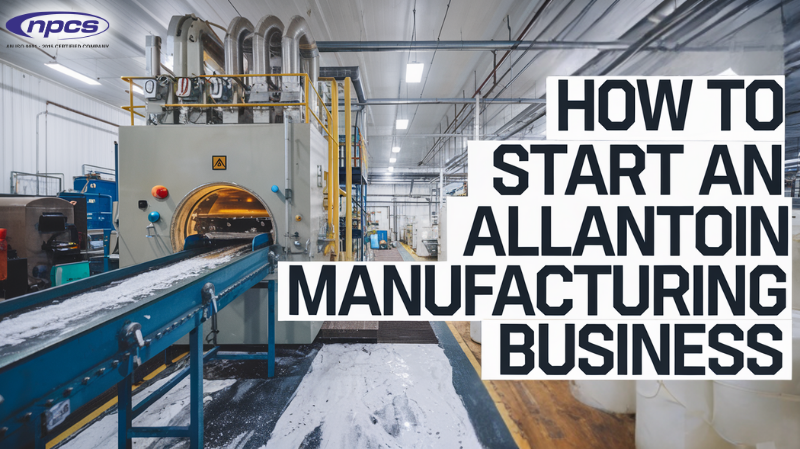Allantoin is an all-around organic constituent whose soothing and healing propositions have made it usable in numerous products such as cosmetics and chemicals. Allantoin is essential in skincare formulations, and wound healing products making the establishment of allantoin manufacturing company; quite rewarding. This article will explain the product – available options, market potential, production steps, and ideas to ensure the triumph.
What is Allantoin?
Allantoin is an organic compound – a white odorless powder most commonly found in mammals’ urine as part of allantoic fluid. It can also be produced by chemical synthesis. It has been widely used in lotion, cream, and ointment because it is a moisturizing agent and helps in skin repair. Allantoin stimulates rejuvenation and eases the healing process of scratches, burns, and irritations, which more than increases the consumption of this compound in different fields.
Why Start an Allantoin Manufacturing Business?
There are a number of attractive aspects regarding the investment in the allantoin corridor:
- Wide Range of Uses: Allantoin finds its application in many sectors- including cosmetic, pharmaceutical, and dermato-social, which gives an assurance of a wide clientele base.
- Market Forces: The allure and keen application of skincare and other beauty products is also on the rise thus apart from being general synthesis of products allow the use of allantoin the demand for its market is.
- Significance in Industries: Allantoin is a significant constituent in the manufacture of cosmetics and medicals, hence, placing your business in a very viable economy sector.
- Flexibility: The manufacturing process can be modified to suit both micro and macro enterprises which can be advantageous in the growth of the business.
Join Us : Niir Projects Consultancy Services
Niir Projects Consultancy Services
Benefits of Starting an Allantoin Business
- Increasing Demand: There shall be a high demand in the international market for allantoin owing to a growing awareness of consumers in skin and personal care.
- Widespread Application: Allantoin use in skincare ingredients, as a healing agent, and on many pharmaceuticals; therefore it is a key component in numerous formulations.
- Capability of Expanding: Businessmen can start on a low-cost production arrangement and maintain it for some time before increasing due to the market requirements.
- Availability of Export Markets: Allantoin is available throughout the globe, thus making it easy for exports and engaging in foreign business interactions.
Top Applications of Allantoin
There are many industrial uses of allantoin:
- Cosmetics: Allantoin is extensively used in moisturizers, creams, and lotions because of its calming and moisturizing benefits.
- Pharmaceuticals: It is found in the composition of numerous medicinal preparations, including those in the form of ointments and creams intended for wound treatment and skin irritations.
- Dermatology: Allantoin is used in many dermatological preparations for its skin-replenishing and anti-inflammatory qualities.
- Personal Care Products: This compound is also present in other several cosmetic formulations such as shampoos and conditioners due to its enhancive effect on the skin and hair.
Production Methods
The preparation of allantoin consists of quite a number of technical processes which include the following:
- Raw Material Procurement: The first step in the production of allantoin is acquiring critical raw materials which include urea and glyoxylic acid.
- Synthesis Process: Allantoin can be synthesized through the reaction of urea and glyoxylic acid or uric acid oxidation among others. It is important to control the conditions of the synthesis to avoid compromising the quality of the product. Industrial and scientific synthesis of the compound
- Separation and Purification: After synthesis, the allantoin is separated from by-products and impurities through filtration and crystallization processes to obtain high purity allantoin.
- Cooling and Storage: The finished products are first cooled down and then provided with special containers to prevent their spoilage before they are packed and transported.
- Safety Measures: There is also the need to enforce the safety measures because of the dangers posed by some of the raw materials. This is so regarding the management of the chemicals in their use and after use.
Read our Book Here: The Complete Technology Book on Chemical Industries
Essential Machinery for Allantoin Manufacturing
To complete the production process in a safe and speedy manner, the establishment of an allantoin production plant requires acquiring certain types of machinery. These machines can be grouped into the following major heads:
- Reaction Vessels: Containers that are made to withstand high temperatures and pressures, which allow the synthesis of allantoin to occur.
- Filtration Systems: Important for removing allantoin-containing impurities and by-products in the gearing.
- Crystallization Equipment: To ensure the predetermined structure and the quality of crystals of the product, in this case, allantoin.
- Cooling Systems: Critical for control of the temperature during the reaction and during the cool down of the end product.
- Storage Tanks: Capable of providing safe storage for both raw materials and finished goods in compliance with health and safety regulations and preserving their quality.
- Ventilation Systems: There is a need to ensure that there is good ventilation within the area so as to get rid of toxic fumes and vapors as well as to provide safety to the workers.
- Safety Equipment:We cannot emphasize enough the importance of warning and limiting fire hazards, implementing shower systems, and using PPE to protect the workers’ wellbeing.
Starting Your Allantoin Manufacturing Business
In order for you to achieve all of the steps in establishing and operating an allantoin manufacturing business, information on the steps is provided below.
Conduct Market Research
It is important to know even the basics of the market. Find out who are the customers for your product, they may be cosmetic, pharmaceutical, and dermatological products manufacturers. Look for the market opportunities, gaps, and the analysis of competitors of your product.
Devise a Strategy to Manage all the Facets of the Business
A business plan is crucial for organizing a business efficiently. It also plays a key role in attracting potential investors. The plan outlines the production, marketing, and financial elements of the business. It includes forecasts for operations and growth. A thoughtfully developed plan is vital for achieving business success and securing funding. It assists entrepreneurs in structuring their business effectively.
Check Laws, Regulations and Standards
This substance is also subject to regulatory controls that are commensurate with its intended use in cosmetics and medicinal drugs. Obtain the required licenses and permits from the relevant authorities and adhere to the health and safety and environmental requirements.
Capital Expenditure on Capital Items as Required
Lease or buy a plant complete with all the required machinery and safety gear. The plant should be compliant with the regulations, properly ventilated, and equipped with firefighting apparatus.
Raw Material Acquisition
Set up an efficient logistic system in place for the distribution of key raw materials such as urea and glyoxylic acid. We will ensure that we secure long-term agreements with suppliers to provide an uninterrupted supply of raw materials for production.
Implement Quality Assurance
Quality values standards and measures are very critical in ensuring the safety and effectiveness of any product. Quality control activities should examine raw materials, supervise operational procedures, and assess finished goods before market distribution at every stage of production.
Marketing and Sales Tactics
Come up with a marketing mix for prospective clients in the beauty and pharmaceutical sectors. Participate in fairs, industry gatherings, and use the online space to market awareness for your allantoin ranges.
Dedicate Resources to R&D
Without Research and Development the chemical sector is stagnant. Put resources into R&D for the upgrading of production methods, product quality and search for new potential for the usage of manufacturers’ allantoin. Trends will always win competition and therefore it is imperative to manage change.
Conclusion
Producing allantoin presents an exciting opportunity for entrepreneurs. Its wide range of applications makes it a distinctive and sought-after product. The growing demand for allantoin supports expanded production efforts. It’s crucial to grasp customer preferences and adhere to regulations. Upholding high quality standards is key to thriving in a competitive market.
Keep Focus on Invention, and Research and Market Intelligence for Sustainability. Quality products, including allantoin, their processing and marketing in accordance with best practices are very promising and almost unlimited.






